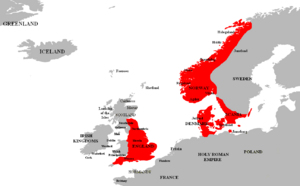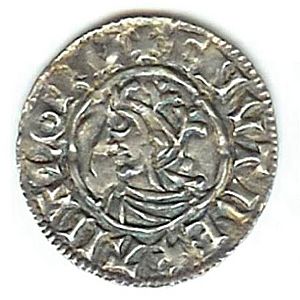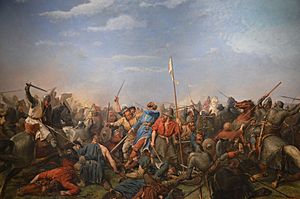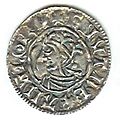Viking activity in the British Isles facts for kids
The Vikings in the British Isles refers to a time from the 700s to the 1000s CE when people from Scandinavia traveled to the British Isles. They came to raid, conquer, settle, and trade. These people are often called Vikings. Some experts wonder if the term "Viking" meant all Scandinavian settlers or only those who used violence.
Before the Viking Age, Scandinavian kingdoms had trade routes that reached far into southern Europe. They traded for silver, gold, bronze, and spices. These trade routes also reached west to Ireland and Britain.
In the late 700s, Viking raiders attacked Christian monasteries in northern Britain. Over the next 300 years, they launched bigger invasions. They settled in many areas, especially in eastern Britain, Ireland, and the islands north and west of Scotland, including the Isle of Man.
Contents
Who Lived in Britain and Ireland?
During the Early Medieval period, the islands of Ireland and Britain had many different groups of people. They had different cultures, languages, and religions.
Celtic Speakers
People in Ireland, parts of western Scotland, and the Isle of Man spoke an early form of Gaelic. In Cornwall, Cumbria, Wales, and southwest Scotland, people spoke Brythonic languages. Modern languages like Welsh and Cornish come from these. The Picts lived in what is now a large part of Scotland. They spoke Pictish. Most experts think Pictish was a Celtic language. Most people in Britain and Ireland had become Christian by this time. Before that, they had many gods.
Anglo-Saxons
In southern Britain, many kingdoms of Anglo-Saxon England had formed. Anglo-Saxon people from Europe had settled there in the 400s CE. They brought their own Germanic language, called Old English. They also had their own religion with many gods. But by the time the Vikings arrived, most Anglo-Saxons were also Christian.
Kingdoms in England
By the mid-800s, Anglo-Saxon England had four main kingdoms: East Anglia, Wessex, Northumbria, and Mercia. Mercia was the strongest. About half a million to a million people lived in England. Society had strict levels. The king and his leaders were at the top. Below them were landholders, then farm workers, and then slaves. Most people lived in the countryside. But large towns like London and York grew as centers for government and religion. Trading ports like Hamwic and Ipswich also developed.
Viking Raids Begin (780s–850)
In the late 700s, Viking raiders began attacking Christian monasteries in the British Isles. These monasteries were often on small islands or remote coastlines. Monks wanted to live quietly and worship. But this also made them easy targets for attacks.
First Recorded Attacks
The first known Viking raid in Anglo-Saxon England happened in 789. Three ships from Norway landed in the Isle of Portland. They killed the king's officer, who came to check on them. There were probably earlier raids that were not written down. A document from 792 shows that Viking raids were already a problem.
In 793, Vikings attacked the monastery at Lindisfarne, an island off England's east coast. The next year, they attacked a nearby monastery. In 795, they raided Iona Abbey off Scotland's west coast. This monastery was attacked again in 802 and 806. After the 806 attack, 68 people were killed, and the monks moved to Ireland. In the early 800s, Vikings also began attacking coastal areas of Ireland. In 835, a major Viking raid hit the Isle of Sheppey in southern England. In 839, Vikings defeated the Picts, killing their king.
Runestones Tell Tales
The England runestones are about 30 runestones in Sweden. They tell stories of Viking Age trips to England. These stones are a big group that mention voyages to other countries. They are similar in number to stones about trips to Greece or the Middle East. They were carved in Old Norse using a special alphabet called Younger Futhark.
English rulers often paid large sums of money, called Danegelds, to Vikings. These Vikings mostly came from Denmark and Sweden in the late 900s and early 1000s. Some runestones mention these payments. For example, the Yttergärde runestone tells of Ulf of Borresta, who received Danegeld three times, including from Cnut the Great. King Cnut sent most of the Vikings who helped him conquer England back home. But he kept a strong bodyguard, called the Þingalið. Members of this group are also mentioned on several runestones.
Most of these runestones (27) are in modern-day Sweden. Seventeen are in the oldest Swedish areas around Lake Mälaren. Denmark has no such runestones, but there is one in Scania that mentions London. There is also one in Norway and a Swedish one in Schleswig, Germany.
Some Vikings, like Guðvér, attacked more than just England. The Grinda Runestone in Södermanland says:
|
Hidden Treasures
Many treasures were buried in England during this time. Some might have been hidden by Anglo-Saxons trying to protect their wealth from Viking raiders. Others might have been buried by Vikings to keep their stolen treasure safe.
One treasure found in Croydon in 1862 had 250 coins, silver bars, and other silver pieces in a linen bag. Experts think this was loot collected by a Viking soldier. They believe it was buried in 872 when the Viking army stayed in London for the winter. The coins came from different kingdoms, including England, France, and the Arab world. Not all Viking treasures had coins. For example, at Bowes Moor in Durham, 19 silver bars were found. At Orton Scar in Cumbria, a silver neck-ring and a special brooch were found.
Historian Peter Hunter Blair thought that the Vikings' success and Britain's lack of preparation were big reasons for the later Viking invasions and settlements.
Viking Invasion and the Danelaw (865–896)
From 865, the Vikings' goal in the British Isles changed. They started to see it as a place to live, not just to raid. Larger armies arrived, planning to conquer land and build settlements. Early Viking settlers looked different from the Anglo-Saxons. They wore Scandinavian jewelry and clothes. Viking men also had different hairstyles: shaved at the back and shaggy in front, while Anglo-Saxons usually wore their hair long.
Viking Control in England
Viking armies captured York, a major city in Northumbria, in 866. Anglo-Saxon counterattacks failed, and many Northumbrian leaders died in a big battle at York in 867.
Other Anglo-Saxon kings started to give in to Viking demands. They surrendered land to Viking settlers. Many areas in eastern and northern England came under the direct rule of Viking leaders or kings they controlled.
King Æthelred of Wessex died in 871 while fighting the Vikings. His younger brother, Alfred, became king of Wessex. The Viking king of Northumbria, Halfdan Ragnarrson, gave his lands to a new wave of Viking invaders in 876. Over the next four years, Vikings gained more land in Mercia and East Anglia. King Alfred continued to fight, but in 878, he was pushed back to Somerset. He had to hide in the marshes of Athelney.
Alfred gathered his forces and defeated the Viking king Guthrum at the Battle of Edington in May 878. After this battle, Alfred and Guthrum agreed to a peace treaty. It set the borders for their kingdoms. This treaty is known as the Treaty of Alfred and Guthrum. It is one of the few documents from Alfred's time that still exists. The areas to the north and east became known as the Danelaw. This meant they were under Viking political influence. The areas to the south and west remained under Anglo-Saxon control.
Alfred's government built a series of defended towns called burhs. He also started building a navy and organized a system where half of his peasant army was always ready to fight. To support these defenses, he created a tax and conscription system.
In 892, a new Viking army with 250 ships arrived in Kent. Another army of 80 ships soon followed. They launched many attacks on Wessex. But Alfred's new defenses worked well. The Viking invaders faced strong resistance and had less success than they hoped. By 896, the invaders spread out. Some settled in East Anglia and Northumbria, while others sailed to Normandy.
Alfred's policy of fighting Viking settlers continued under his daughter, Æthelflæd, and her brother, King Edward the Elder (who ruled from 899–924). When Edward died in 924, his son Æthelstan became king. In 927, he conquered York, the last Viking kingdom. This made him the first Anglo-Saxon ruler of all England. In 934, he invaded Scotland and forced their king to submit. But the Scots and Vikings did not like Æthelstan's rule. In 937, they invaded England. Æthelstan defeated them at the Battle of Brunanburh. This victory gave him great fame and led to the end of Viking power in northern Britain. After his death in 939, the Vikings took back control of York. It was finally reconquered in 954.
Edward's son Edmund became king in 939. When Edmund was killed, his younger brother, Eadred, became king. In 947, the Northumbrians rejected Eadred and made the Norwegian Eric Bloodaxe their king. Eadred responded by invading Northumbria. When the Saxons went back south, Eric Bloodaxe's army attacked them. Eadred threatened to destroy Northumbria in revenge. So, the Northumbrians turned against Eric and accepted Eadred as their king. The Northumbrians then changed their minds again and accepted Olaf Sihtricsson as their ruler. But Eric Bloodaxe removed him and became king of Northumbria again. Then, in 954, Eric Bloodaxe was expelled for the last time by Eadred. Bloodaxe was the last Norse king of Northumbria.
Second Viking Invasion (980–1012)

England Under New Attacks
Under King Edgar the Peaceful of Wessex, England became more united. Edgar was seen as the king of all England by both Anglo-Saxon and Viking people. However, under his sons Edward the Martyr (who was murdered in 978) and then Æthelred the Unready, the English monarchy became weaker. In 980, Viking raiders from Scandinavia started attacking England again.
The English government decided to pay the attackers "protection money." In 991, they gave them £10,000. This payment was not enough. Over the next ten years, the English kingdom had to pay the Vikings larger and larger sums of money. Many English people wanted a tougher approach against the Vikings. So, on St. Brice's Day in 1002, King Æthelred ordered that all Danes living in England be killed. This event became known as the St. Brice's Day massacre.
News of the massacre reached King Sweyn Forkbeard in Denmark. It is believed that Sweyn's sister was among the victims. This led Sweyn to raid England the next year, burning Exeter. Hampshire, Wiltshire, Wilton, and Salisbury also suffered from the Viking revenge attack. Sweyn continued his raids, looting East Anglia, Thetford, and Norwich in 1004, before returning to Denmark.
More raids happened in 1006–1007. From 1009–1012, Thorkell the Tall led another Viking invasion into England.
In 1013, Sweyn Forkbeard returned to invade England with a large army. Æthelred fled to Normandy, and Sweyn took the English throne. However, Sweyn died within a year. Æthelred returned, but in 1016, another Viking army invaded. This time, it was led by the Danish King Cnut, Sweyn's son. After defeating Anglo-Saxon forces at the Battle of Assandun, Cnut became king of England. He ruled both the Danish and English kingdoms. After Cnut's death in 1035, the two kingdoms became separate again. They stayed separate, except for a short time from 1040 to 1042 when Cnut's son Harthacnut became king of England.
The Battle of Stamford Bridge (1066)
In 1066, Harald Hardrada, the King of Norway, invaded England. He had 300 longships and 10,000 soldiers. He wanted to claim the English throne after the death of King Edward the Confessor. He had early success, defeating the forces of Northumbria and Mercia at the Battle of Fulford. While celebrating his victory and getting ready to move south, Harald's army was surprised. King Harold Godwinson's army had marched all the way from London in just one week.
The invasion was stopped at the Battle of Stamford Bridge. Hardrada and most of his men were killed. While the Viking attempt failed, the Norman invasion that happened almost at the same time was successful in the south at the Battle of Hastings. Hardrada's invasion and defeat are often seen as the end of the Viking Age in Britain.
What We Know from Old Writings
Experts James Graham-Campbell and Colleen E. Batey noted that there are not many old writings about the very first Viking meetings with the British Isles. These first meetings probably happened in the northern islands, which were closest to Scandinavia.
The Irish Annals give us many stories about Viking activity in the 800s and 900s.
The England Runestones, mostly found in Sweden, tell stories of the voyages from the Viking point of view.
The Viking raids on Anglo-Saxon England were mainly written about in the Anglo-Saxon Chronicle. This was a collection of yearly records first written in the late 800s, likely in Wessex during King Alfred the Great's rule. However, the Chronicle is not completely fair. It was like "wartime propaganda" written for the Anglo-Saxons against the Vikings. In many cases, it made the Viking fleets and armies seem much bigger than they were. This made any Anglo-Saxon victories seem more heroic.
What Archaeology Tells Us
Viking settlers in the British Isles left behind objects and structures. Archaeologists have been able to dig these up and study them in the 1900s and 2000s. This Viking evidence in Britain mostly includes Viking burials found in Shetland, Orkney, the Western Isles, the Isle of Man, Ireland, and northwest England. Archaeologists James Graham-Campbell and Colleen E. Batey said that the Isle of Man has "remarkably rich" Norse archaeology in both quality and quantity.
However, archaeologist Julian D. Richards noted that finding Scandinavians in Anglo-Saxon England can be hard for archaeologists. This is because many of their houses and graves look similar to those of other people living in the country. Because of this, historian Peter Hunter Blair said that in Britain, the archaeological evidence for Viking invasion and settlement is "very slight" compared to the evidence for the Anglo-Saxon invasions in the 400s.
Images for kids
See also





